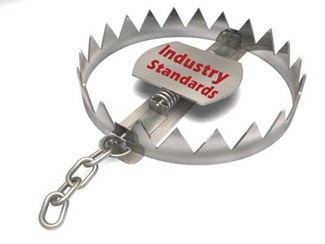If our main goal as a business is to be different, then how come we all end up looking pretty much the same? Because really we spend more time trying to be better, rather than different. True differentiation is not about better service, more features, longer hours. It’s about creating something unexpected that changes the game. And that’s why attending trade association and industry events can be bad for your differentiation. They teach us how to be better day spas, better fitness clubs, better employment agencies, but they rarely teach us how to be different.
Competing within your industry is a trap. Going head-to-head with your competitors eliminates the possibility that you will create meaningful separation from the pack. Because trying to be better than your competition relegates you to chasing the same thing your competitor is chasing. You may or may not be better, but you will definitely be undifferentiated.
At the urging of Brand Autopsy’s John Moore, I’m reading Youngme Moon’s Different. I suggest you do, too. Moon says that comparison causes us to be more like our competitors, not different. We work on raising our weaknesses to reach, or exceed, our competitor’s level. For example, a typical jewelry store, offers just about everything you could want from a jewelry store. From a $60 gold heart pendant to $12,000 wedding rings, all showcased in a glass-covered, well-lit display case. Then the jewelry store’s competitor down the street decides to offer watch repair. In an effort to be well-rounded, the former jewelry store quickly adds the service. Moon says,
“…true differentiation, sustainable differentiation, is rarely a function of well-roundedness; it is typically a function of lopsidedness.”
That means truly differentiated businesses rarely look like their competitor, or their industry. Let’s use Apple as an example. If I ask you who is Apple’s competitor, you might be just as likely to say HP, Microsoft, Motorola, Nokia, SanDisk, Amazon, or Google. Then if I challenge you to tell me what industry Apple is in, you would probably be able to come up with four or five legitimate industries. But really, the only industry in which Apple belongs is the industry of innovation. They are lopsided in innovation.
One industry in which you will rarely find any lopsidedness is the radio station industry. Radio stations killed off any differentiation by becoming homogeneous, well-rounded radio stations. They all stick to a formula: Play a particular genre of music or become a talk station. Put wacky, controversial personalities on the air, or become “less-talk.” Play as few commercials as possible and have contests to keep people listening. It’s a formula that ensures if you’ve heard one radio station in one town, you’ve heard all radio stations in all towns.
Throw those industry formulas in the trash.
What should you do about your industry trap? Maybe this is about what you shouldn’t do. Maybe you shouldn’t think you belong to any particular industry at all. Maybe you shouldn’t think that you have any competition. How would that free up your thinking and allow you to be different?
If you enjoyed this article, consider subscribing to this blog and let future podcast episodes and articles come to you: Receive The Marketing Spot by Email or Get The Marketing Spot in a blog reader


[…] by Youngme Moon You might also be interested in… Branding: Subtract the Scope, Add the Focus Industry Trappings: How not to be different. The Best in Branding Articles for Small […]